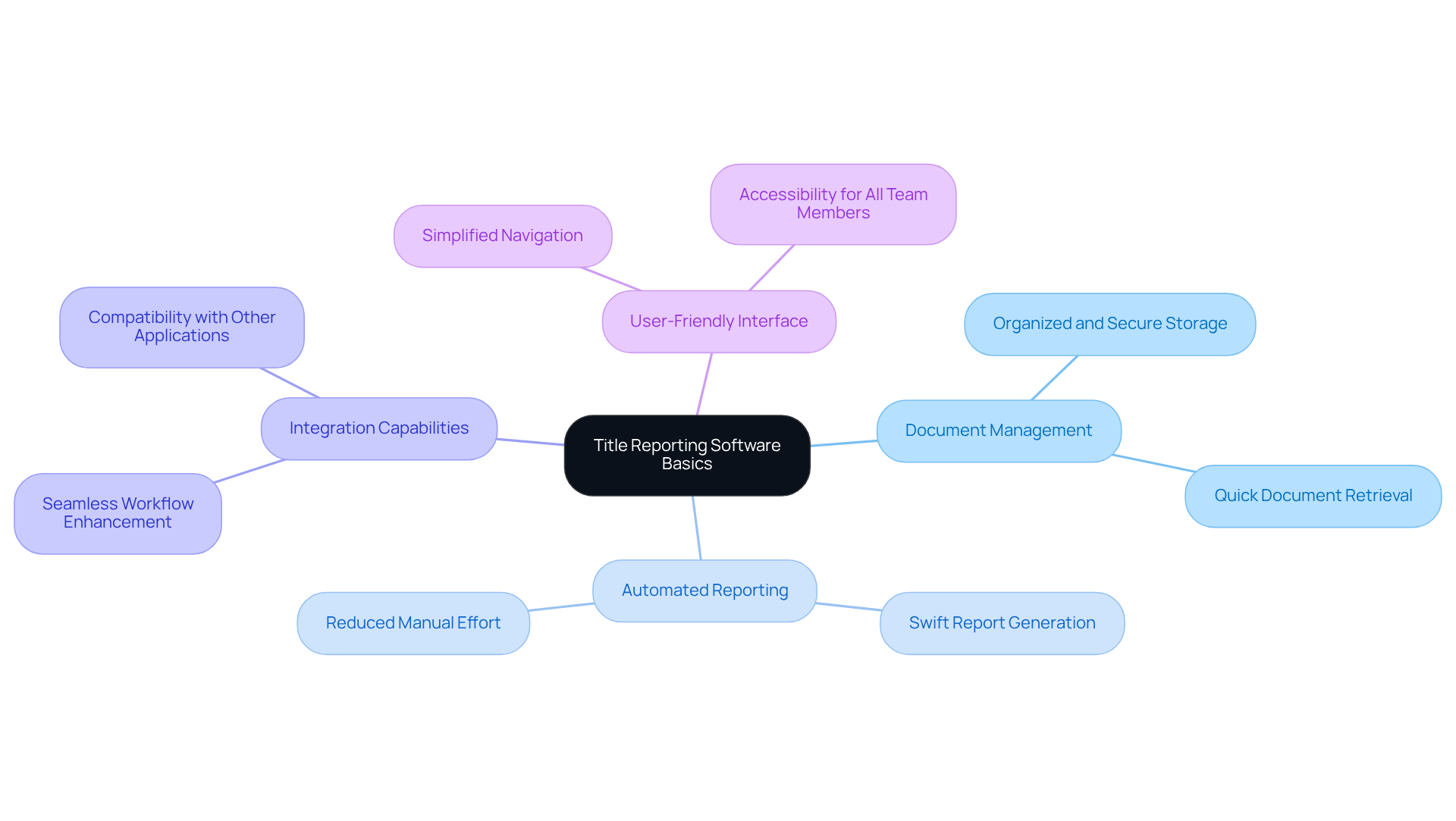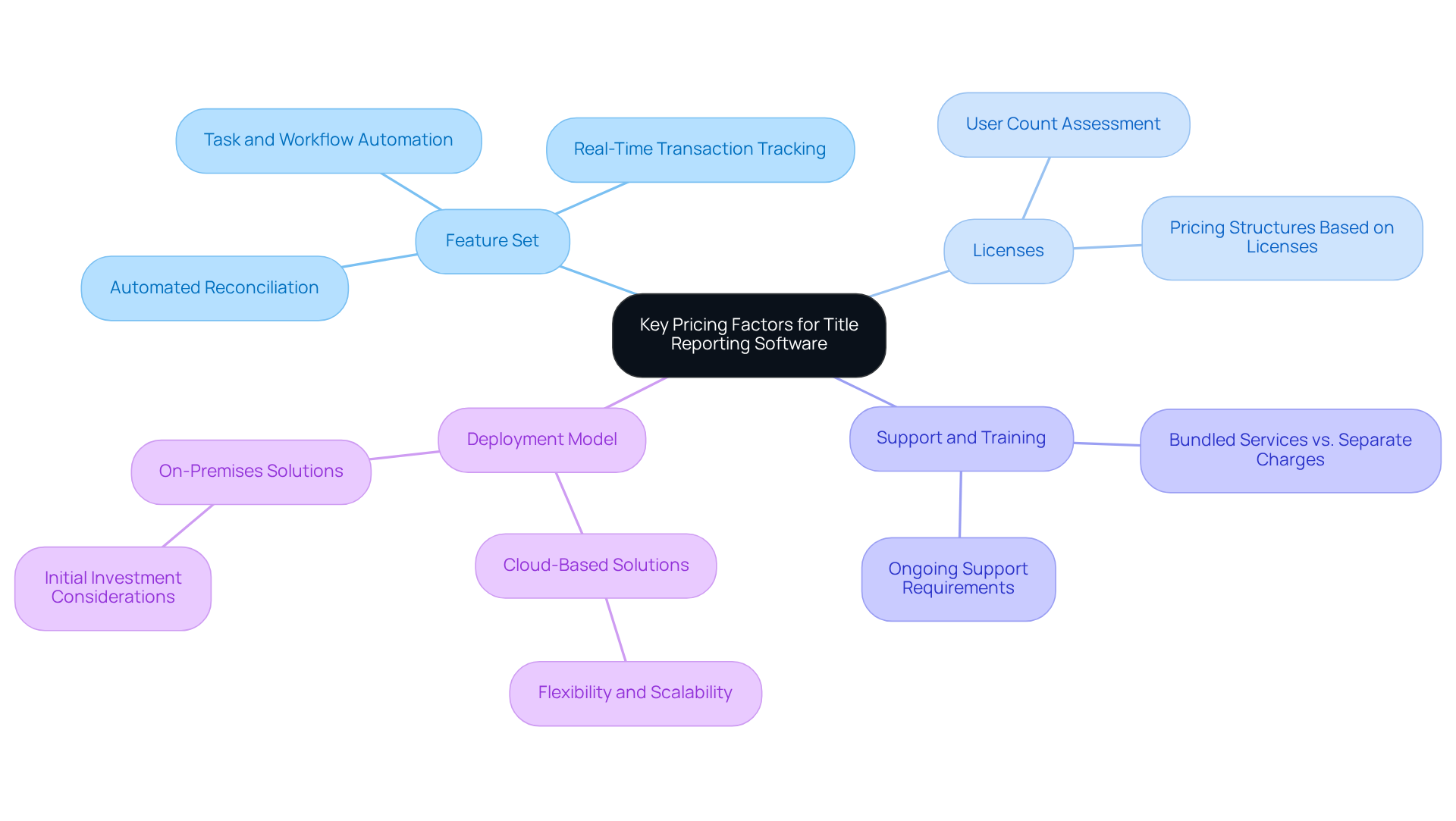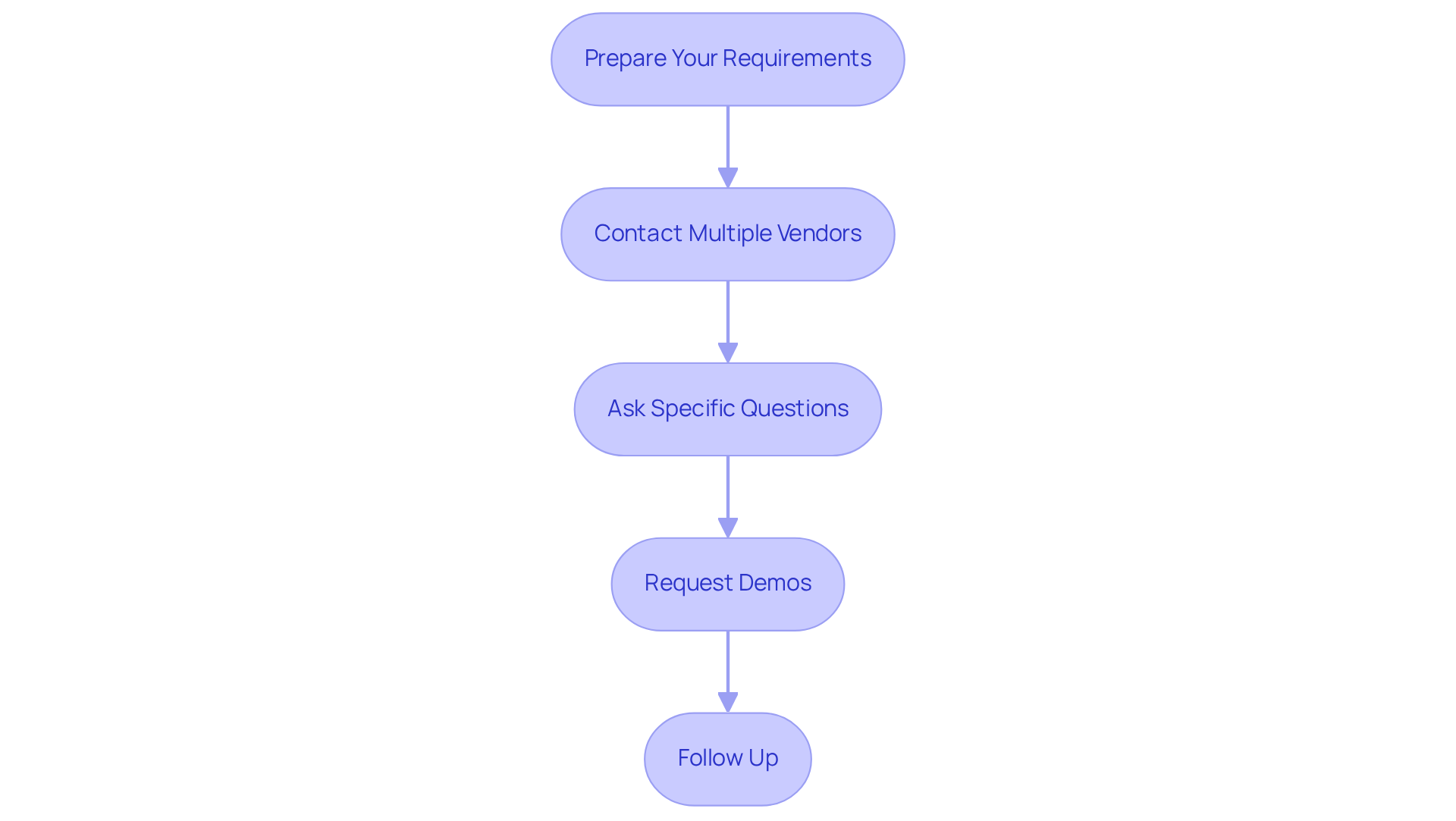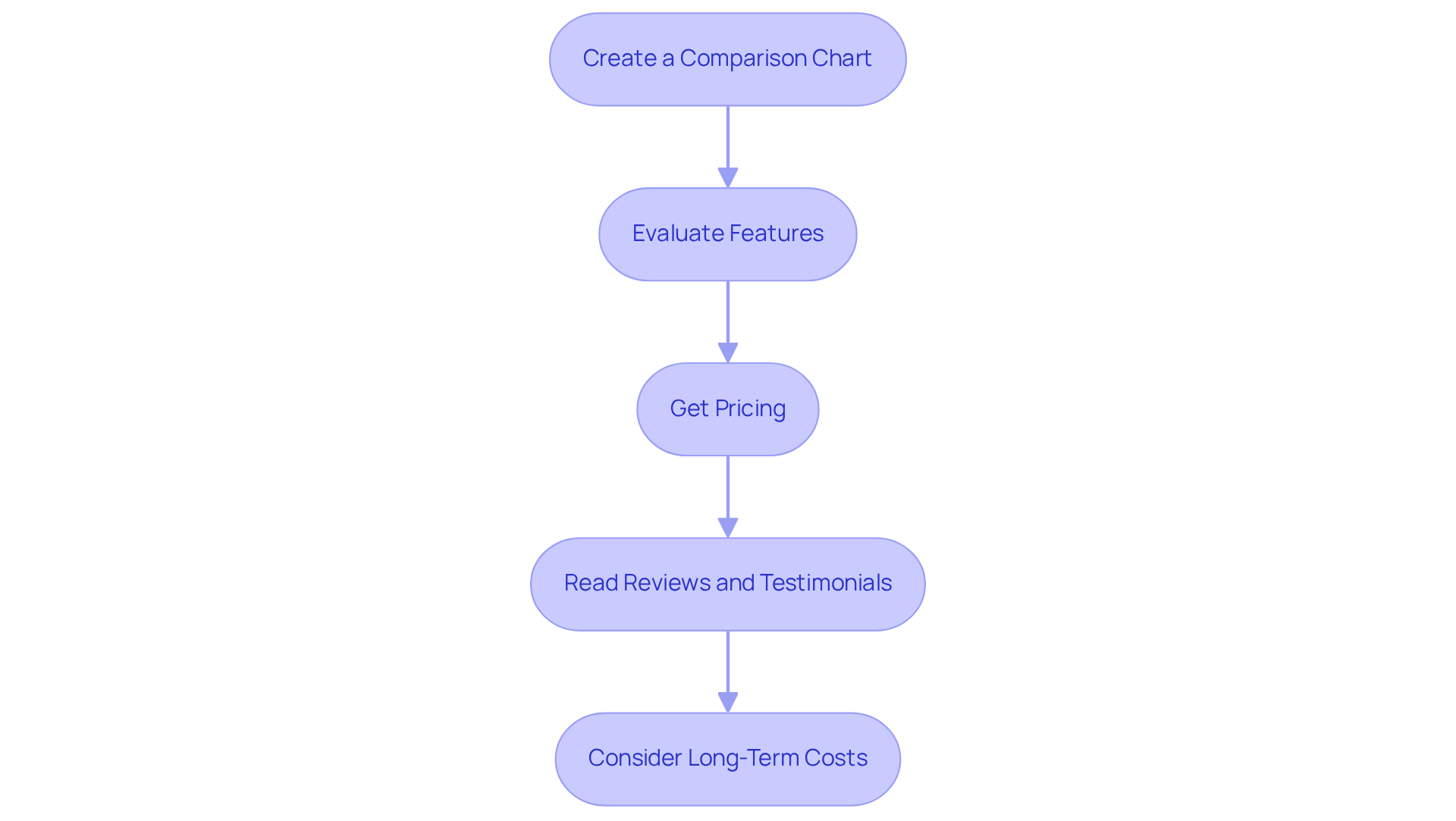Overview
This article details the essential steps required to obtain pricing for title reporting software, highlighting the critical need to understand key features, pricing factors, and the importance of effective communication with vendors. It emphasizes the significance of accurate title research and the challenges that may arise in the process. Furthermore, it outlines essential elements such as:
- Document management
- Automated reporting
- Integration capabilities
In addition, the article provides a comprehensive guide for requesting and comparing pricing information, ensuring informed decision-making and ultimately driving the audience towards actionable solutions.
Introduction
Navigating the complexities of title reporting software presents a significant challenge for real estate professionals, particularly as the market increasingly relies on technology to enhance efficiency. Grasping the essential features and pricing factors of these software solutions is vital for making informed decisions that align with operational needs and budget constraints.
However, with a multitude of options available, how can one ascertain they are selecting the right software that not only meets their requirements but also delivers optimal value?
This guide provides a step-by-step approach to obtaining pricing for title reporting software, equipping readers with the knowledge necessary to streamline their decision-making process and maximize their investment.
Understand Title Reporting Software Basics
For real estate professionals, it is essential to get pricing for title reporting software, as it streamlines the management and creation of report documents. Its key features include:
- Document Management: This functionality ensures that title documents are organized and securely stored, crucial for maintaining compliance and facilitating quick access. Effective document management allows users to retrieve documents in seconds, significantly reducing the time spent on searches.
- Automated Reporting: By swiftly generating title reports, the application reduces manual effort, enabling professionals to concentrate on more strategic tasks. The global real estate technology market is projected to grow at a compound annual growth rate (CAGR) of 12.8% from 2023 to 2030, with a market size of USD 10.89 billion in 2023 and an expected revenue of USD 25.39 billion by 2030, underscoring the increasing reliance on such technologies.
- Integration Capabilities: The ability to work seamlessly with other real estate applications enhances workflow efficiency, allowing users to leverage multiple functionalities without disruption. This integration can encompass CRM systems, property management tools, and financial applications, creating a comprehensive ecosystem for real estate operations.
- User-Friendly Interface: A simplified navigation experience ensures that all team members can utilize the application effectively, regardless of their technical expertise. This accessibility is vital for teams with varying levels of comfort with technology.
Understanding these essential elements will enable you to choose a system that aligns with your specific operational requirements, which will ultimately help you get pricing for title reporting software and enhance productivity and precision in reporting. Furthermore, industry leaders emphasize the importance of document management in reporting, asserting that 'effective document management is essential for compliance and operational efficiency.' Considering these insights will further guide your decision-making process.

Identify Key Pricing Factors for Title Reporting Software
When evaluating title reporting software, it is imperative to consider several critical pricing factors:
- Feature Set: The complexity and range of features significantly influence pricing. Advanced functionalities, such as automated reconciliation and real-time transaction tracking, typically incur higher costs. Identifying which features are vital for your operations is essential to avoid unnecessary expenses.
- Licenses: The number of licenses required can greatly affect total expenses. Pricing structures often vary based on user count, making it crucial to accurately assess your team's needs to prevent overpayment.
- Support and Training: Vendor offerings differ in terms of support and training inclusions. Some may bundle these services into their costs, while others may charge separately. Evaluating your team's requirements for training and ongoing support will help you select a vendor that aligns with your operational needs. Clarity in costs is paramount; ensure there are no concealed fees or deceptive tactics.
- Deployment Model: The choice between cloud-based and on-premises solutions can lead to different pricing structures. Cloud solutions frequently offer flexibility and scalability, whereas on-premises applications might necessitate a larger initial investment. Consider your budget and operational preferences when making this decision.
By understanding these factors, you can better anticipate costs and select a reporting solution that allows you to get pricing for title reporting software, aligning with your financial constraints and operational requirements.

Request Pricing Information from Software Vendors
To effectively request pricing information from software vendors, adhere to the following steps:
- Prepare Your Requirements: Clearly define your needs, including the number of users, essential features, and any specific integrations necessary for your title reporting system.
- Contact Multiple Vendors: Reach out to at least three different vendors to compare their offerings. Utilize email or their contact forms for initial inquiries to ensure a broad perspective on available options.
- Ask Specific Questions: Inquire about different cost structures, potential hidden fees, and the availability of discounts for long-term contracts or multiple licenses. This will help you understand the total cost of ownership.
- Request Demos: Ask for a demonstration of the application to gain insights into its capabilities and determine if it aligns with your operational needs. This step is crucial for assessing usability and functionality.
- Follow Up: If you do not receive a timely response, follow up to ensure your request is being processed. Prompt communication can often lead to better engagement and faster responses.
By following these steps, you can gather comprehensive cost information that will greatly assist you to get pricing for title reporting software in your decision-making process. Industry specialists highlight the significance of transparent communication and detailed comparison when assessing costs, ensuring that you make a knowledgeable decision that aligns with your business objectives.

Compare Pricing and Features of Different Title Reporting Software
To effectively compare pricing and features of different title reporting software, it is essential to follow these key steps:
- Create a Comparison Chart: Compile a comprehensive list of the software options under consideration, detailing their key features and pricing structures. Consider referencing effective comparison charts to guide your evaluation.
- Evaluate Features: Identify essential features for your operations, such as automated reporting, document management, and customer support.
- Get Pricing: To get pricing for title reporting software, analyze pricing models by investigating how each vendor structures their pricing—whether it is subscription-based, involves one-time fees, or is usage-based.
- Read Reviews and Testimonials: Consult reviews from clients on platforms like G2 and Capterra to assess satisfaction levels and performance metrics. User satisfaction ratings can significantly impact your choice, as they provide insights into real-world experiences with the application.
- Consider Long-Term Costs: Account for potential future expenses, including upgrades or additional licenses, to gain a comprehensive understanding of the financial commitment involved.
Incorporating insights from industry leaders about the importance of user reviews in application selection can further enhance your evaluation. By conducting a thorough comparison, including relevant statistics and case studies from specific title reporting software like Qualia or SoftPro, you can confidently select the title reporting software that aligns with your operational needs and budget constraints.

Conclusion
Understanding the pricing for title reporting software is essential for real estate professionals aiming to enhance their operational efficiency. By concentrating on critical features such as document management, automated reporting, and integration capabilities, organizations can streamline their processes while ensuring compliance and user accessibility. The right software not only facilitates quicker report generation but also bolsters strategic decision-making, allowing teams to focus on higher-level tasks.
Key factors that influence the pricing of title reporting software encompass the feature set, licensing needs, support and training offerings, and deployment models. By meticulously evaluating these aspects, businesses can circumvent unnecessary costs and select a solution that aligns with their specific requirements. Furthermore, adopting a structured approach to requesting pricing information from multiple vendors can yield valuable insights, ensuring that organizations make informed decisions based on comprehensive comparisons.
Ultimately, investing time in understanding the features and pricing of title reporting software can lead to substantial improvements in productivity and reporting accuracy. As the real estate technology landscape continues to evolve, effectively leveraging these tools will be crucial for maintaining competitiveness. Engaging with vendors transparently and conducting thorough evaluations will empower professionals to choose the optimal software solution tailored to their operational needs and budget constraints.
Frequently Asked Questions
What is title reporting software?
Title reporting software is a tool designed for real estate professionals to streamline the management and creation of report documents, enhancing productivity and compliance.
What are the key features of title reporting software?
The key features include document management, automated reporting, integration capabilities, and a user-friendly interface.
How does document management benefit users of title reporting software?
Document management ensures that title documents are organized and securely stored, facilitating quick access and compliance, which significantly reduces the time spent on searches.
What advantages does automated reporting provide?
Automated reporting swiftly generates title reports, reducing manual effort and allowing professionals to focus on more strategic tasks.
What is the projected growth of the real estate technology market?
The global real estate technology market is projected to grow at a compound annual growth rate (CAGR) of 12.8% from 2023 to 2030, with an expected market size of USD 25.39 billion by 2030.
How do integration capabilities enhance the use of title reporting software?
Integration capabilities allow the software to work seamlessly with other real estate applications, enhancing workflow efficiency and creating a comprehensive ecosystem for real estate operations.
Why is a user-friendly interface important in title reporting software?
A user-friendly interface ensures that all team members can effectively utilize the application, regardless of their technical expertise, which is vital for teams with varying levels of comfort with technology.
How can understanding these features help in choosing title reporting software?
Understanding these essential elements enables users to select a system that aligns with their specific operational requirements, ultimately enhancing productivity and precision in reporting.




